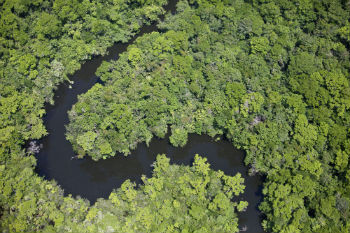Biogeographically, the Himalayan Mountain Range straddles a transition zone between the Palearctic and Indo-Malayan realms. Species from both are represented in the hotspot. In addition, geological, climatic and altitudinal variations in the region, as well as topographic complexity, contribute to the biological diversity of the mountains along their east-west and north-south axes.
Plants
Of the estimated 10,000 species of plants in the Himalaya Hotspot, about 3,160 are endemic, as are 71 genera. The largest family of flowering plants in the hotspot is the Orchidaceae, with 750 species.
A zone of permanent ice and rock begins at about 5,500-6,000 meters. In spite of these harsh conditions, there are records of vascular plants occurring at some of the highest elevations on Earth. Cushion plants have been recorded at more than 6,100 meters, while a high-altitude scree plant in the mustard family, Ermania himalayensis, was found at 6,300 meters on the slopes of Mt. Kamet in the northwestern Himalayas.
Birds
Nearly 980 birds have been recorded in the hotspot, but only 15 are endemic. Avian flagships include the Endangered white-winged duck (Asarcornis scutulata), Critically Endangered white-bellied heron (Ardea insignis) and Critically Endangered Bengal florican (Houbaropsis bengalensis).
Mammals
About 300 mammal species have been recorded in the Himalaya, including a dozen that are endemic to the hotspot—the Endangered golden langur (Trachypithecus geei) and Critically Endangered pygmy hog (Sus salvanius) among them.
The alluvial grasslands support some of the highest densities of the Endangered tiger (Panthera tigris) in the world, while the Brahmaputra and Ganges rivers that flow along the foothills also support globally important populations of the Endangered South Asian river dolphin (Platanista gangetica). Some of the world's last remaining populations of the Endangered wild water buffalo (Bubalus arnee) and Vulnerable swamp deer (Cervus duvaucelii) are restricted to protected areas in southern Nepal and northeastern India.
Reptiles
Although there has been little systematic study of reptiles and amphibians in the Himalaya Hotspot, at least 175 reptiles have been documented, of which nearly 50 are endemic. There is just one endemic genus, represented by a single species, the lizard Mictopholis austeniana, known only from the holotype. Other genera are well represented, and have many endemic species. These include Oligodon, Cyrtodactylus and Japalura.
Amphibians
Among amphibians, there are 105 species known to occur in the hotspot, more than 40 of which are endemic. Most of these are frogs and toads, although there are also two species of caecilians, one of which, Ichthyophis sikkimensis, is endemic and occurs in northern India and extreme eastern Nepal at elevations of 1,000 to 1,550 meters.
Freshwater fishes
Fish species from three major drainage systems, the Indus, Ganges and Brahmaputra, inhabit the Himalaya Hotspot, although the ranges of many species only just reach into the cold, high-altitude waterways of this region. As a result, only 30 of nearly 270 species are endemic.
Read about species in the former Eastern Himalayas Hotspot (now part of the Himalaya and Indo-Burma hotspots) in our ecosystem profile (PDF - 3.4 MB).




